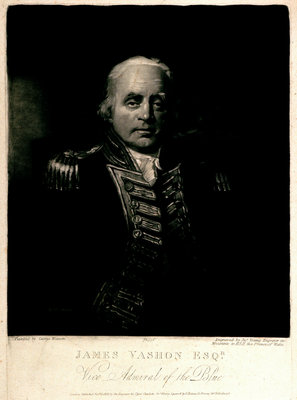
Admiral James Vashon was a British officer of the Royal Navy. He saw service during the Seven Years' War, the American War of Independence and the French Revolutionary and Napoleonic Wars. He was first captain of HMS Dreadnought, between 1801 and 1802. Previously, he had commanded Alert (1781), Europa (1786), and Formidable.

Admiral Sir Alexander Inglis Cochrane, GCB was a Royal Navy officer and politician who served in the French Revolutionary and Napoleonic Wars and achieved the rank of admiral of the blue. He captained HMS Ajax off Alexandria, Egypt during the French invasion of Egypt and Syria.
Peter Puget was an officer in the Royal Navy, best known for his exploration of Puget Sound, which is named for him.

Rear-Admiral Sir Robert Barrie was a British naval officer noted for his service in the War of 1812. He was helped early in his naval career by the patronage of his uncle, Sir Alan Gardner, who arranged for him to take part in the Vancouver Expedition. When the Pacific Coast was explored, he had served as a midshipman with Captain Vancouver in 1791.

HMS Discovery was a Royal Navy ship launched in 1789 and best known as the lead ship in George Vancouver's exploration of the west coast of North America in his famous 1791-1795 expedition. She was converted to a bomb vessel in 1798 and participated in the Battle of Copenhagen. Thereafter she served as a hospital ship and later as a prison hulk until 1831. She was broken up in 1834.

Arthur Fleming Morrell was British officer of the Royal Navy, an explorer, and Commandant of Ascension Island, who saw service spanning the end of the Napoleonic era and well into the Victorian era.

HMS Chatham was a Royal Navy survey brig, built in 1788, that accompanied HMS Discovery on George Vancouver's exploration of the West Coast of North America in his 1791–1795 expedition.
Joseph Baker (1767–1817) was an officer in the Royal Navy, best known for his role in the mapping of the Pacific Northwest Coast of America during the Vancouver Expedition of 1791–1795. Mount Baker is named after him.

Joseph Whidbey FRS was a member of the Royal Navy who served on the Vancouver Expedition 1791–95, and later achieved renown as a naval engineer. He is notable for having been the first European to discover and chart Admiralty Island in the Alexander Archipelago in Alaska in 1794.

The Vancouver Expedition (1791–1795) was a four-and-a-half-year voyage of exploration and diplomacy, commanded by Captain George Vancouver of the Royal Navy. The British expedition circumnavigated the globe and made contact with five continents. The expedition at various times included between two and four vessels, and up to 153 men, all but 6 of whom returned home safely.
Admiral ZacharyMudge was an officer in the British Royal Navy, best known for serving in the historic Vancouver Expedition.

Admiral Alan Gardner, 1st Baron Gardner, was a British Royal Navy officer and peer of the realm. He was regarded by some as one of the Georgian era's most dashing frigate captains and, ultimately, a respected senior admiral.
HMS Dictator was a 64-gun third-rate ship of the line of the Royal Navy, launched on 6 January 1783 at Limehouse. She was converted into a troopship in 1798, and broken up in 1817.

HMS Dragon was a 74-gun third rate ship of the line of the Royal Navy, launched on 2 April 1798 at Rotherhithe. She was designed by Sir William Rule, and was the only ship built to her draught.

Admiral Sir Thomas Pasley, 1st Baronet was a senior and highly experienced British Royal Navy officer of the eighteenth century, who served with distinction at numerous actions of the Seven Years' War, American Revolutionary War and French Revolutionary Wars. In his youth he was renowned as an efficient and able frigate officer and in later life became a highly respected squadron commander in the Channel Fleet. It was during the latter service when he was awarded his baronetcy after losing a leg at the Glorious First of June, aged 60.
Volant Vashon Ballard CB was a Rear-Admiral of the Royal Navy. He served as a midshipman with George Vancouver on his voyage to the north-west coast of America.

William Young was an officer of the Royal Navy who saw service during the American War of Independence, and the French Revolutionary and Napoleonic Wars. He should not be confused with his namesake and near contemporary Vice Admiral William Young.
James Johnstone was a British naval officer and explorer. He is noted for having served as sailing master of the armed tender HMS Chatham and later acting lieutenant during George Vancouver's 1791–1795 expedition to the Pacific Northwest. Johnstone Strait in British Columbia is named after him.

HMS Prince William was a 64-gun third-rate ship of the line of the Royal Navy. She had previously been Guipuzcoano, an armed 64-gun ship of the Spanish (Basque) mercantile Guipuzcoan Company of Caracas. She was also known by the religious name of Nuestra Señora de la Asunción.
Perçante was a 20-gun ship-corvette of the French Navy, built at Bayonne and launched in 1795. The British captured her in 1796 and took her into the Royal Navy under the name HMS Jamaica. They rated her as a sixth-rate 26-gun frigate. She served during both the French Revolutionary Wars and part of the Napoleonic Wars, during which she captured some privateers and participated in a boat attack. The Admiralty had her laid up in 1810 and sold her in 1814.













